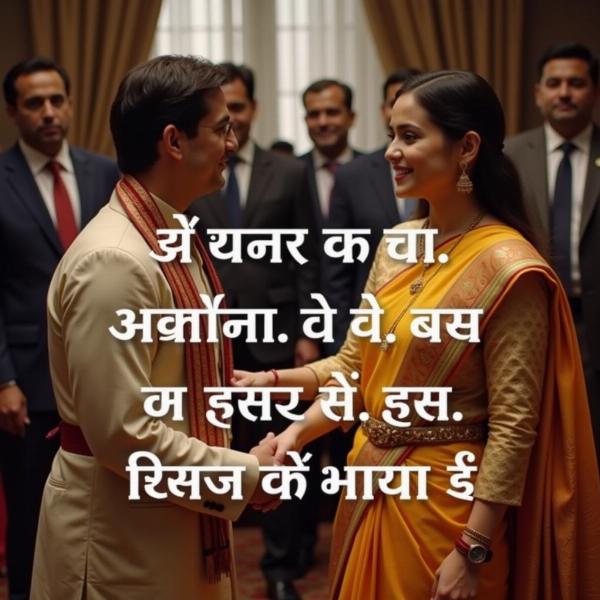Understanding how to greet someone politely and make a good first impression is crucial in any culture. If you’re learning Hindi or interacting with Hindi speakers, knowing how to say “pleased to meet you” is essential. This article will delve into the various ways to express this sentiment in Hindi, covering both formal and informal contexts, and providing cultural insights to help you navigate social interactions with confidence.
Different Ways to Say “Pleased to Meet You” in Hindi
There isn’t a single, direct translation of “pleased to meet you” in Hindi that captures the exact nuance. Instead, several phrases convey similar meanings depending on the formality of the situation and your relationship with the person you’re meeting.
Formal Greetings
In formal settings, or when meeting someone older or of higher status, these phrases are appropriate:
- आपसे मिलकर खुशी हुई (Aapse milkar khushi hui): This is the most common and versatile formal way to express pleasure at meeting someone. It translates literally to “I am happy to meet you.”
- आपसे मिलकर अच्छा लगा (Aapse milkar achha laga): This phrase translates to “It was good to meet you” and is suitable for both initial meetings and when parting ways.
- आपसे परिचित होकर प्रसन्नता हुई (Aapse parichit hokar prasannata hui): This is a more formal and literary way of expressing pleasure at making someone’s acquaintance.
Informal Greetings
When meeting peers, friends, or people younger than you, these more casual phrases work well:
- मिलकर अच्छा लगा (Milkar achha laga): A shortened, more informal version of “Aapse milkar achha laga.”
- तुमसे मिलकर खुशी हुई (Tumse milkar khushi hui): Similar to the formal “Aapse milkar khushi hui,” but using the informal pronoun “tum.” Only use this with people you know well.
Responding to Greetings
When someone greets you with one of these phrases, you can reciprocate with the same phrase or simply say:
- मेरी भी (Meri bhi): Meaning “Me too.”
- मुझे भी (Mujhe bhi): Another way to say “Me too.”
 Formal Hindi Greetings
Formal Hindi Greetings
Cultural Considerations
Beyond the specific phrases, understanding the cultural context surrounding greetings in India is important. Here are some key points to remember:
- Respect for Elders: Indian culture places a strong emphasis on respecting elders. Using the formal greetings is essential when interacting with older individuals.
- Namaste: While not a direct translation of “pleased to meet you,” the traditional greeting “Namaste” (नमस्ते) with folded hands shows respect and is appropriate in most situations.
- Handshakes: Handshakes are becoming more common, especially in urban areas and professional settings. However, be mindful that some women may prefer not to shake hands. Observe and follow the lead of the person you’re meeting.
- Titles and Honorifics: Using appropriate titles like “Ji” (जी) after a person’s name, especially for elders or those in positions of authority, demonstrates respect.
Beyond the First Meeting
Once you’ve made the initial greeting, continuing the conversation politely and showing genuine interest in the other person is crucial. Asking about their well-being, family, or work (in a professional context) demonstrates respect and helps build rapport.
What to Say After “Pleased to Meet You”
- आप कैसे हैं? (Aap kaise hain?): How are you? (Formal)
- क्या हाल है? (Kya haal hai?): How are you? (Informal)
Conclusion
Knowing how to say “pleased to meet you” in Hindi is a valuable skill for anyone interacting with Hindi speakers. By using the appropriate phrases and being mindful of cultural nuances, you can make a positive first impression and build strong relationships. Whether you use “Aapse milkar khushi hui” in a formal setting or “Milkar achha laga” among friends, expressing your pleasure at meeting someone goes a long way in fostering connection and respect.
FAQ
- What is the most common way to say “pleased to meet you” in Hindi? Aapse milkar khushi hui (आपसे मिलकर खुशी हुई) is the most common and versatile formal expression.
- Can I use “Namaste” instead of “pleased to meet you”? While not a direct translation, “Namaste” is a respectful greeting suitable for most situations.
- Is it appropriate to shake hands in India? Handshakes are becoming more common, especially in professional settings, but be observant of cultural preferences.
- What should I say after the initial greeting? Inquire about the person’s well-being using phrases like “Aap kaise hain?” (formal) or “Kya haal hai?” (informal).
- How do I show respect when greeting elders in Hindi? Use formal greetings, address them with respect using titles like “Ji,” and avoid overly casual language.
Meaning-Hindi.in: Your Trusted Partner for Hindi Translations
Meaning-Hindi.in provides high-quality translation services between Hindi and various other languages. We specialize in business, legal, technical, website localization, educational, and specialized translations, offering fast and accurate services to meet your needs. Whether you need to translate business documents, legal contracts, technical manuals, or educational materials, our team of expert linguists ensures accurate and culturally sensitive translations. Contact us today at [email protected] or call +91 11-4502-7584 to discuss your translation project. Meaning-Hindi.in is your one-stop solution for all your Hindi translation requirements.